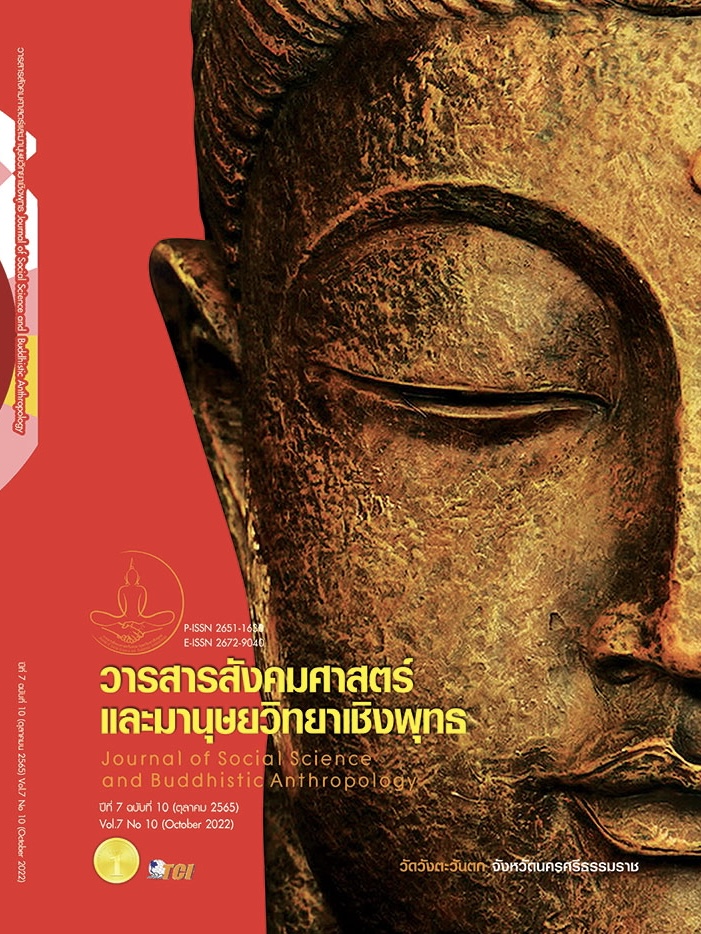USING A TOTAL COMMUNICATION SYSTEM TO DEVELOP QUESTIONING SKILLS OF A CASE STUDY WITH DEAFBLINDNESS
Keywords:
Total Communication System, Questioning Skills, DeafblindnessAbstract
The objective of this research article were to study the effect of using a total communication system to develop questioning skill. “What is your name?” of a 22-year-old case study, deafblindness female. The case study was chosen by purposive sampling. The tools used for this research were 1) four individual implementation plans (IIPs) focusing on the total communication system to develop the questioning skill and 2) observation form for questioning skill development. In each activity of teaching, the researcher used the total communication system for the specified Four steps: reading braille on cards, sending cards, asking questions in sign language, and answering questions in sign language. The researcher used Four teaching techniques, demonstration by hand over Hand, hand under hand technique, physical prompt, and reinforcement. The statistics used for analyzing data were frequency distribution, median, and presenting data by using tables and description. The results from Three teaching activities, the case study practiced asking questions with 6 people, totaling 18 people as follows. The first result, the researcher demonstrated by hand Under hand technique 9 times and demonstrated by hand instruction 10 times. The median of reading braille on cards = 2, sending cards = 2, asking questions in sign language = 1 and answering questions in sign language = 3. The second result, the researcher demonstrated by hand Under hand technique 2 times and demonstrated by hand instruction 8 times. The median of reading braille on cards = 3, sending cards = 3, asking questions in sign language = 2 and answering questions in sign language = 3. The third result, the case study can be followed in steps, use total communication to ask questions herself. The median of reading braille on cards, sending cards, asking questions in sign language, and answering questions in sign language = 3 respectively.
References
กุลยา ก่อสุวรรณ และยวุดี วิริยางกูร. (2560). การสอนและการช่วยเหลือบุคคลที่มีความบกพร่องทางสติปัญญาและเรียนรู้ช้า (ฉบับปรับปรุงครั้งที่ 2). เชียงใหม่: มหาวิทยาลัยเชียงใหม่.
ทิศนา แขมมณี. (2551). ศาสตร์การสอน: องค์ความรู้เพื่อการจัดกระบวนการเรียนรู้ที่มีประสิทธิภาพ. กรุงเทพมหานคร: จุฬาลงกรณ์มหาวิทยาลัย.
นิทัศน์ วีระโพธิ์ประสิทธิ์. (2545). การพัฒนาบทเรียนคอมพิวเตอร์ช่วยสอนสำหรับนักเรียนที่มีความบกพร่องทางการได้ยินด้วยวิธีการสื่อสารรวม. ใน วิทยานิพนธ์การศึกษามหาบัณฑิต สาขาวิชาเทคโนโลยีทางการศึกษา. มหาวิทยาลัยบูรพา.
ประกาศกระทรวงศึกษาธิการ. (2552). กำหนดประเภทและหลักเกณฑ์ของคนพิการทางการศึกษา 2552. ราชกิจจานุเบกษา. 126 (ตอนพิเศษ 80 ง) 47 (8 มิถุนายน 2552).
รื่นฤทัย สัจจพันธุ์. (2553). ความหมายของ_คำทักทาย_. เรียกใช้เมื่อ 2 สิงหาคม 2565 จาก https://hahahailoveyou.wordpress.com/%E0%B8%84%E0%B8%A7%E0%B8%B2%E0%B8%A1%E0%B8%AB%E0%B8%A1%E0%B8%B2%E0%B8%A2%E0%B8%82%E0%B8%AD%E0%B8%87_%E0%B8%84%E0%B8%B3%E0%B8%97%E0%B8%B1%E0%B8%81%E0%B8%97%E0%B8%B2%E0%B8%A2_/
วิวัฒน์ มีสุวรรณ์. (2557). การตั้งคำถามเพื่อการเรียนรู้. พิษณุโลก: ภาควิชาเทคโนโลยีและสื่อสารการศึกษา มหาวิทยาลัยนเรศวร.
อธิพงษ์ เพ็ชรเกิด. (2555). วัจนกรรมทักทายของนักศึกษามหาวิทยาลัยเชียงใหม่. พะเยา: คณะศิลปศาสตร์ มหาวิทยาลัยพะเยา.
อัชรา เอิบสุขสิริ. (2557). จิตวิทยาสำหรับครู (พิมพ์ครั้งที่ 2). กรุงเทพมหานคร: สำนักพิมพ์แห่งจุฬาลงกรณ์มหาวิทยาลัย.
Aitken, S. et al. (2000). Teaching children who are deafblind. London: David Fulton Publishers.
Bruce, S. M. (1999). Communication intervention for children who are congenitally deafblind: the influence of an in-service with follow-up approach on teacher thinking and practice. In Doctor of Philosophy. Michigan State University.
Brum, C. (2016). Literacy supporting communication development for children with congenital deafblindness. In Doctoral dissertation. Boston College University.
Deasy, K. & Lyddy, F. . (2009). Exploring language and communication in an individual with congenital deafblindness: a case study. In Report to the National Council for Special Education Special Education Research Initiative . The National Council for Special Education Special Education Research Initiative.
Duquette, J. (2012). Communication between people with deafblindness: how could it be facilitated? Information monitoring summary. Longueuil : Institut Nazareth et Louis-Braille.
Helen Keller Institute for Deaf and Deafblind. (2020). What is multiple disability with visual Impairment (MDVI). Retrieved May 19, 2020, from http://www.hkidb- mumbai.org/what_is_mdvi.php
Hersh, M. (2013). Deafblind People, Communication, Independence, and Isolation. National Library of Medicine, 18(4), 446-63.
Milies, B. & Riggio, M. (1995). Remarkable conversation: a guide to developing meaningful communication with children and young adults who are deafblind. Watertown: MA: Perkins School for the Blind.
National Center on Deaf-Blindness. (2019). 2019 National Deaf-Blind Child Count Report. Retrieved August 12, 2021, from https://www.nationaldb.org/ products/national-child-count/report-2019/demographics/
Octave Speech and Hearing, Bangalore. (2020). Understanding prompting hierarchy. Retrieved May 27, 2020, from https://avazapp.com/blog/understanding-prompting-hierarchy/
Rowland, C. (1994). Communication matrix questions and answer options. Retrieved November 2, 2017, from http://www.gadoe.org/Curriculum-Instruction-and-Assessment/Special-Education-Services/Documents/Vision/VI%20 Consortia%205-8-15/Communication%20Matrix%20Questions.pdf
Sense International. (2019). Total communication. Retrieved December 18, 2020, from https://www.sense.org.uk/get-support/information-and-advice/com munication/total-communication/
The Northern School for The Blind under patronage of the Queen. (2020). Information system. Retrieved January 24, 2020, from https://www.cmblind. ac.th/th/information-system
The World Federation of the Deafblind. (2018). First global report on deafblindness. Retrieved August 12, 2021, from https://senseinternational.org.uk/about-deafblindness/first-global-report-deafblindness
Thorndike, E. L. (1923). Education a first book. New York: The Macmillan Company.
Webster, J. (2019). Hand over hand prompting for children with disabilities. Retrieved February 16, 2021, from https://www.thoughtco.com/hand-over-hand-prompting-3110838
Downloads
Published
How to Cite
Issue
Section
License
Copyright (c) 2022 Journal of Social Science and Buddhistic Anthropology

This work is licensed under a Creative Commons Attribution-NonCommercial-NoDerivatives 4.0 International License.








